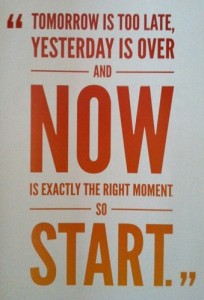There you are happy as can be, having more fun than you ever imagined. Your product is operating just as you hoped it would. And yet, you can’t do the happy dance of success. Why not? Nobody’s buying what you’ve got to sell.
You see, it doesn’t matter how good you are at serving up widgets if your clients don’t see any value to those perfectly formed gems.
An example of a mind-baffling gift from Maine Department of Transportation (MDOT) sits right in my backyard. There’s a park-and-ride lot in my town that can accommodate 300 cars. It seems, though, that MDOT forgot to tell us why we need this lot, and just who needs this lot. An article at the end of 2013 in a local paper reported that area students have found an alternate use for the lot. The lot, with its flat terrain and no obstacles (i.e., cars) becomes a training area for roller-skiers.
Built on the theory that if you build it, they will come, these photos taken June 25 reflects typical  usage of the lot. If it were an ad, it would be the ultimate representation of use of white space. Not so good for a park-and-ride lot. So…yes, a great park and ride. BUT – whom is this lovely lot intended to serve? How about a marketing plan here? Or is word of mouth going to build usage over time? Hmmm…stay tuned on that one.
usage of the lot. If it were an ad, it would be the ultimate representation of use of white space. Not so good for a park-and-ride lot. So…yes, a great park and ride. BUT – whom is this lovely lot intended to serve? How about a marketing plan here? Or is word of mouth going to build usage over time? Hmmm…stay tuned on that one.
Few companies have the time MDOT has to wait for people to discover their need for a product. So how can you make sure you’re offering products and services that will be embraced by your clients?
- Meet with your clients to find out what they like about your current offerings. Ask for their input: What is it about your service / product that keeps them coming back for more? What could you do that would make their lives even better?
- While you’re hearing how wonderful your product is, don’t miss the opportunity to ask your clients what you could be doing better. Don’t defend against the short-comings. Thank your clients for their honesty here. AND – follow up on these points later. Maybe there’s a fix in the works; maybe there’s already a fix that your client didn’t know about. Or, maybe it’s back to the drawing board for you.
- Share results with your co-workers. Have brainstorming sessions. The collective power of sharing information can be transformational.
- Test drive before launch. Let a select group see what it is you’ll be offering up; this will help build a loyal following. It will also make sure you’re heading in the right direction even if you take the Steve Jobs approach: “It’s really hard to design products by focus groups. A lot of times, people don’t know what they want until you show it to them.”
- Create and implement a marketing and communication plan.
While there is no foolproof plan to guarantee the success of every service and product, you can easily reduce the likelihood of providing a service (or a park and ride) that nobody knows they need.















